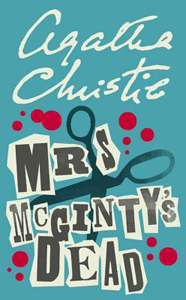“Mrs. McGinty’s Dead” (1952, also published as “Blood Will Tell”) ranks as one of Agatha Christie’s most complex mysteries. In the country village of Broadhinny where the title character is murdered, Poirot believes the killer is someone going by an alias. In the past, they were known by a different name, and they were either a killer or associated with one.
The past comes back
Christie has used this concept before. But this case’s possibilities are sprawling. The killer could be any of a dozen people in the village. And their original identity could be any of four mysterious women profiled (with old photographs) in a tabloid. Or a relative of one of these women.
It’s almost impossible for a reader to successfully ferret out the killer. Although “Mrs. McGinty’s Dead” is a page-turner like most Christies, I found it hard to remember who is who, even though I didn’t go long between each reading session.

“Mrs. McGinty’s Dead” (1952)
Also published as: “Blood Will Tell”
Author: Agatha Christie
Genre: Mystery
Series: Hercule Poirot No. 32, Ariadne Oliver No. 3
Setting: Broadhinny, England, 1952
It’s even harder to remember the backstories of the four photographed women. This is because they aren’t characters, they are ciphers – even to Poirot. Their backstories might not even be accurate. The article’s writer tells Poirot she’s interested in selling papers, not accuracy.
So, depending on if you think the complexity is a bug or a perk, “Mrs. McGinty’s Dead” could rank as one of the best or one of the worst Christie mysteries.
Poirot’s musings
Other aspects fare better. The author aims to make this a good Poirot character piece, and she mostly succeeds. The Belgian sleuth laments that his dear friend Hastings isn’t with him, and I wondered “Why doesn’t Christie write Hastings into the story?”
The upside is we get Poirot’s inner thoughts. Among the amusing topics are the value of treating one’s stomach well, an annoyingly uncomfortable lodge, and his irritation at not being recognized.
On the serious side, Poirot’s sense of justice is on display, as he works to free a convicted but innocent man: Mrs. McGinty’s lodger, James Bentley. He has an unpleasant personality, but that’s not enough reason for Poirot or veteran police investigator Spence to want to see him take the rap. As in chapter 20:
Really, thought Poirot, one might as well let him be hanged since he does not seem to care …
No, he would not go so far as that.
Bentley’s very personality, in fact, is why Spence initially suspects the man has been framed: He’s not cocky enough to be a murderer.
Putting it together
Without Hastings present, Spence serves as Poirot’s sounding board. Their conversations culminate in a great line of comedy in chapter 24, as Spence is annoyed that Poirot won’t yet share his conclusion:
It was after that remark that there was very nearly another murder – the Murder of Hercule Poirot by Superintendent Spence in Kilchester Police Headquarters.

It’s an apt line for this novel because by this point we’re as anxious as Spence is for Poirot to sort out this 5,000-piece puzzle for us. Even though Christie uses several epilogs to explain why various people were acting suspicious, this remains a messy novel.
I’ve already forgotten who the killer is, even though I finished the book yesterday. In the long – even by Poirot’s standards – oratory where he reveals what happened, it’s almost like “Clue.” Poirot goes through several possibilities before landing on what really happened.
More than the mystery
Yet “Mrs. McGinty’s Dead” is a fun read, because it offers a lot other than the mystery itself. Christie goes meta with recurring character Ariadne Oliver (“Cards on the Table”), a mystery novelist who is working with a playwright to adapt her Finnish sleuth to the stage.
By 1952, about 10 of Christie’s novels and stories had been adapted to TV and film, and more to the stage. So I suspect Oliver’s frustrations mirror Christie’s, even though the hefty, apple-obsessed Oliver isn’t a strict stand-in for the author.
More meta-commentary comes from Oliver’s frustrations with readers pointing out factual inaccuracies. Here, Christie references her own “Death in the Clouds,” where she invents a foot-long blowgun. A reader informs Oliver that blowguns are 6 feet long.
“Mrs. McGinty’s Dead” offers many talking points. It stands as a core exhibit of how Poirot thinks about issues other than the mystery in front of him. And the Oliver stuff is fun.
But if a reader claims they came anywhere close to solving this one – or even following all the details – I’d look at them with as much suspicion as if they lived in Broadhinny.
Every week, Sleuthing Sunday reviews an Agatha Christie book or adaptation. Click here to visit our Agatha Christie Zone.

